Displaying items by tag: W M Nixon
Rock Breaking Records
#fastnet – Why are people surprised that, despite the international mood of economic gloom, online entries for the Rolex Fastnet Race 2013 in August went through the roof earlier this week, with the ceiling of 300 boats – nine of them Irish - hit in record time, well within 24 hours of the lists opening, with the first one in just seven seconds after the gun fired?
Fact is, the Fastnet is incredibly good value for money for ordinary offshore sailors based along either side of the English Channel, and on both coasts of the southern North Sea. It's set up on a plate ready-to-go, its start and finish are within convenient sailing distance of them all, yet it's an event of historic and almost mythic global status, made even more so by the disastrous storm of 1979.
To have it in your sailing CV, regardless of where you place at the finish, is still something which mightily impresses non-sailing colleagues at work, and down the pub too if you live more than half a dozen miles from the sea. Yet taking part in it is no big deal financially for the English Channel/Southern North Sea sailors when you factor in the enormous number of existing boats which are well capable of doing it.
If we set aside the original cost of the boat by regarding that transaction as history and not part of the new financial equation, thanks to today's much more rigorous inter-governmental safety and equipment standards, it's not too onerous to bring an ordinary production performance cruiser up to the RORC requirements.
So taking the existence and ownership of the boat as a given, what is needed is enthusiasm, energy, the availability of shipmates, and that precious place in the entry list. It's a setup which suits Offshore Sailing Schools very well indeed – they made extra sure of securing their entries, and are pushing above 10% of the total list. As for private owners, for some nowadays the entry place seems to have become top of the priorities, and people are securing their slot in the hope of then putting their campaign together on the basis of this essential building block. Either way, there's already a waiting list, but it can activate into entry acceptance remarkably quickly, even if some secured entries hang on until the last minute, days after it's clear they'll be no-shows.
Back in 2007, one of Ireland's greatest offshore skippers, Ger O'Rouke of Limerick, was campaigning his Cookson 50 Chieftain with enormous vigour, and in June/July he raced the Transatlantic from New York to Hamburg. But he had an understandable superstition about finalizing his entry for the next big race before finishing the race of the moment, and thus when Chieftain got into Hamburg, she may have won her class and placed second overall, but as far as the Fastnet Race 2007 was concerned, she was still only No 46 on the waiting list.
But Ger took her down to the Solent, and based himself in the Hamble to be near the scene of the action, making sure the Fastnet race office knew he was there and ready to go, so that as places became available from the waiting list, the over-worked race officers could be sure that one boat at least was a certain substitute. Meanwhile he was also keeping an eye on other boats in uncertain pre-Fastnet mode around the Hamble, because after the time-consuming Transatlantic campaign, Ger was a bit short of crew, and he was quietly sussing out Fastnet hopefuls to make up his numbers if he got the call.
Less than 48 hours before the race was due to start, Chieftain was in. So in terms of accepted boat management practice, you might say she was a last minute entry, with her crew numbers completed by pierhead jumpers. Having cleared the acceptance hurdle, they frustratingly couldn't get racing right away, as the start was postponed for a day because of a Force 9 south'wester. Even when it did get going in quite a rugged slug to windward down the English Channel, something like 150 boats soon retired.
But Chieftain was loving it, though even before she'd bashed her way past the Lizard, all the installed electronics crashed. They navigated the rest of the race with a little handheld GPS and a few wet and disintegrating paper charts. Not to worry, they had a hugely acclaimed overall win, the first ever by an Irish boat, and Ger O'Rourke was Ireland's Sailor of the Year 2007. Not bad going for a last-minute entry crewed by pierhead jumpers.
With stories like this cascading down the years, it's little wonder the Fastnet is something special. And though it involves a little more effort for Irish boats to get to the start, it's still a mega-happening within easy reach, tantalizingly so when rounding the rock itself. Thus although we've only managed a sneak preview of the initial entry list, and while accepting that some may fall by the wayside because of rigorous crew requirements further down the lines, nevertheless the news is it's good news, Ireland has a quality entry, and there'll be much more to it than simply having the Fastnet Race in the old sailing CV.
In alphabetic order, they're Alchimiste (JPK 9.60, Mike Murphy), Antix (Ker 39, Anthony O'Leary), David Kenefick Sailing (Figaro II, Marcus Hutchinson), Jedi (J/109, Andrew Sarratt) Joker (J/109, Chris Andrews), Lula Belle (First 36.7, Liam Coyne), Lynx Clipper (Reflex 38, Aodhan Fitzgerald), Raging Bull (Sigma 400, Matt Davis) and Spirit of Jacana (J/133, Andrew, Bruce & James Douglas).
At least three other boats have special Irish interest – Nick Martin's J/105 Diablo-J, currently RORC Yacht of the Year after winning the two-handed championship including the double handed division in the round Ireland, with Dun Laoghaire's Andrew Boyle signed on to crew again, and the two recent round Ireland winners - Laurent Gouy's Ker 39 Inis Mor, and Piet Vroon's Ker 46 Tonnere de Breskens.
Of the directly Irish boats, we note that the O'Leary family's Antix – a sister-ship of Inis Mor – has never done a major long offshore race before, not even the Round Ireland, but she's has won oodles of stuff round the cans and in shorter offshores, so her transference to the wide open spaces will be interesting. Further down the line, Lynx Clipper entered by Aodhan Fitzgerald is of course NUI Galway, the Reflex 38 which is current ICRA Boat of the Year. And it's good to see Matt Davis's successful Sigma 400 Raging Bull (ISORA Champion 2011) back in the lists – she missed 2012 completely through coming ashore in Skerries in a nor'east gale in May, but has now been restored by Noonan Boats down Wicklow way.
Young David Kenefick's Figaro programme under the tutelage of Marcus Hutchinson will be well under way by Fastnet time, and this should provide useful publicity and unmatchable experience. As for the hot J/109s of Dublin Bay, two of them – Jedi and Joker – have made the cut, while their bigger sister, the Douglas brothers' J/133 Spirit of Jacana from Carrickfergus, is back again to defend her position as top-placed Irish boat in 2011. Smallest of all the Irish entries is Mike Murphy's JPK 9.60 Alchimiste – at 31ft she has one of the shortest overall lengths in the entire fleet, but with her beam upwards of 11ft she's a big-hearted little 'un, an impressive French creation.
We don't know at this stage which Irish boats are on the waiting list, but as it is that's a good solid lineup, with some welcome surprises. Looking at the fleet overall, defender Ran (JV 72, Niklas Zennstrom) is going again, as too is mono-hull record holder, the Volvo 70 Abu Dhabi (Ian Walker). There's a notable absence of American boats this time round (though their successful JV 72 Bella Mente is in the hunt), but we should bear in mind that the next Rolex Fastnet, in 2015, will coincide with the Bi-Centenary of the Royal Yacht Squadron, so we can expect the New York Yacht Club to be leading a formidable expeditionary force to events around that, including the Fastnet Race.
And looking beyond that, it's not too long to the Tri-Centenary of the Royal Cork in 2020. For Royal Cork's Quarter Millennium in 1970, they made it a two year event to accommodate American boats planning to take in the 1969 Fastnet. Doubtless plans are already well in hand to do that again with the Rolex Fastnet Race of 2019.........Put it in your diary now.
GLORIOUS GALATEA AND HAPPY HENN
There was some scepticism about last week's piece about Ireland's first America's Cup Challenger in 1886. Not as to whether it had taken place – it's quite clear in the America's Cup records that in 1886, Lt William Henn had challenged through the Royal Northern Yacht Club with his new cutter Galatea. No, the disbelief was about the notion that Lt Henn and his supportive wife and their crew (including Peggy the pet monkey) had lived aboard Galatea, which stayed on in America in order to challenge again the following Spring, as Henn reckoned the Autumn breezes off Marblehead were too light.
We've since unearthed this antique photo of Galatea's main saloon, which would suggest that you could have lived aboard the big steel cutter in rather more luxurious comfort than the Henn family's many tenants would have enjoyed in their small farms along the north shore of the Shannon Estuary. But in terms of America's Cup racing potential, it tells us why Galatea was just about as effective as a Shannon gandolow in taking on the American defender Mayflower, an Edward Burgess designed 100ft cutter which won every race whether Autumn or Spring, the biggest margin being a whopping 29 minutes and 9 seconds.
Yet today the fascination is with Galatea's extraordinary saloon, which seems to have at least two leopardskin rugs, and a proper fireplace – absolutely essential in any proper racing yacht. As to William Henn retaining his modest naval title of Lieutenant, it seems that he took early retirement from the Royal Navy in order to go sailing, his personal fortune being sufficient to do so, and he was so keen on sailing the sea that before Galatea was built on the Clyde in 1885, he lived aboard his previous yacht for seven years.
At the time of his challenge, the American press commented on "this retired Naval Officer with his rich Irish charm", while his gallant wife seems to have been Scottish, hence his challenge through the Royal Northern YC, and other links to the Clyde. This makes it unlikely that the remains of Galatea can be found (as is popularly supposed) in the Fergus estuary on the north shore of the Shannon estuary, off the remains of Paradise which was the old Henn house. According to Lloyd's Register of 1910, Mrs Henn is still listed as owning Galatea, but is now apparently a widow, and resident on the Isle of Bute, while Galatea is listed as being in proper order, but having her base at Port Glasgow.
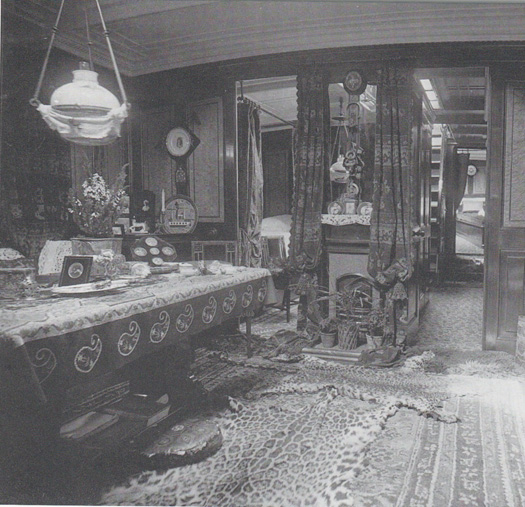
The main saloon on the Irish-owned 1886 America's Cup challenger Galatea provided all comforts and catered for every possible need, except the needs of a racing boat.
Brian Craig is December Sailor of the Month
#sailorofthemonth – As we look back over the extraordinary mixture of memories stirred up by the Irish sailing season of 2012, one exceptionally good deed stands out in a sometimes slightly wicked world.
Questions were asked about some major events in Ireland and abroad during 2012, while in others, distasteful rows blew up which could have been much more competently handled. But over and above it all, and glowing with increasing strength as the passing of time enhances the recollections, is the happy memory of the Four Star Pizza ISAF Youth Worlds in Dun Laoghaire in July.
With 63 nations involved, it was the most international sailing event ever seen in Ireland. It involved the active input of an army of volunteers ashore, and a navy of volunteers afloat. With so many people taking part at some level or other, the scope for friction – at the very least – was incalcuable.
Yet the ISAF Youth Worlds seemed to effortlessly achieve that true spirit of local, national and international goodwill to which to many comparable events aspire, but not all realize. It made a lasting impact, and was lavishly and deservedly praised by outgoing ISAF President Goran Petersson at the ISAF Conference in November.
Only with a very exceptional administrator and delegator leading an inevitably complex organization can such a satisfactory outcome be achieved. Irish sailing in general, and Dublin Bay in particular, is fortunate in being able to call on the services of Brian Craig to lead the administration in events as demanding as the ISAF Worlds. Not only did he put in the long hours necessary to ensure its smooth running, but long beforehand he gave generously of his time to ensure that Dublin Bay's claim to stage this event was internationally acknowledged and approved. Brian Craig is the Afloat.ie "Sailor of the Month" for December in celebration of his unrivalled contribution to the sailing season of 2012.
IT'S GREEN FOR GO IN HOBART
Irish sailors in Australia have been on a roll in the annual 628-mile Rolex Sydney Hobart Race, with major input into the crewing of the two top boats. After a virtually perfect race in tactical and navigational terms, veteran owner Bob Oatley's hundred footer Wild Oats XI took line honours, and in doing so knocked 16 minutes off the course record she established in 2005.
As Oatley's team - headed by skipper Mark Richards – constantly update and re-tune the big boat, the Wild Oats which established the new record yesterday was a very different beast from the winner of 2005. But the course they had to sail was the same challenging slog down the coast of New South Wales, across the Bass Strait, and up the often flukey estuary of the Derwent River to the city centre finish in Hobart.
One false call from experienced navigator Adrienne Cahalane – whose people hail from Offaly – and a mountain of effort beforehand and afloat would have amounted to nothing. But after blasting away from a perfect start to establish what is believed to be a record for the first short stage from the harbour to Sydney Heads, Wild Oats never put a foot wrong.
At times she was even showing as the overall handicap leader, which is unusual for the biggest boat in the fleet. But for much of the race, the handicap lead was being battled between the defending champion, Steve Ainsworth's 63ft Loki with Gordon Maguire (originally from Howth) as sailing master, and the hot new boat on the block, Peter Harburg's 66ft Black Jack, whose crew - including Olympic Gold Medallist Tom Slingsby - made no secret of targeting Loki.
Being slightly larger, Black Jack seemed to be establishing an unassailable lead, as the quicker you could get south, the more favourable the easterly winds became. This meant that far ahead, not only did Wild Oats end up sailing her own race, but she carried the breeze right to the end, while the wind was losing power out at sea. As the hours ticked by after the big boat was finished, the chances of either Black Jack or Loki saving their time on the Oatley boat evaporated. Wild Oats XI had the treble – line honours, course record, and overall win. But in the private race with Black Jack, Maguire and his team somehow found extra microns of performance, and though they were beaten by Wild Oats by more than two hours on corrected time, they in turn beat Black Jack by 2 hours 3 minutes.
It's a good weekend for Irish sailing down Hobart way. Jeff Condell of Limerick was also on the race, on the strength of veteran skipper Syd Fischer's 100ft Ragamuffin Loyal, and though with some gear breakages they weren't able to match the blistering pace set by Wild Oats, they still took second on line honours, quite an achievement when you remember the hands-on skipper is 85 and his unmatchable CV in sailing includes the overall Fastnet win way back in 1971.
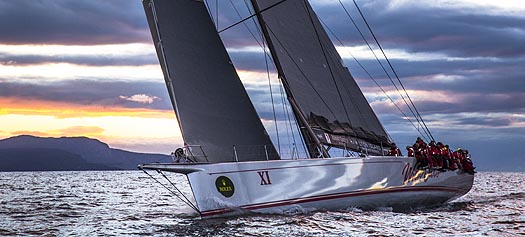
Wild Oats on track for the treble in the Rolex Sydney Hobart 2012. Photo: Daniel Forster/Rolex
SO FAREWELL THEN, EUROPEAN YEAR 2012 FOR ACTIVE AGEING AND SOLIDARITY BETWEEN GENERATIONS, AND HELLO TO THE GORB
Did you know that we've just lived through European Year 2012 for Active Ageing & Solidarity Between Generations? Me neither. And even if someone had told me, I'd have forgotten the beginning of a title of such length and contrivance before I'd even got through to the end.
May God in His Mercy protect us from well-meaning bureaucracies. We know that there are agencies in Brussels which make a tidy living out of putting an often costly structure on activities which any healthy local community would regard as so normal as to be scarcely worthy of comment. But the European Commission for Employment, Social Affairs, and Inclusion, with its European Year 2012 for AA & SBG, surely takes the biscuit.
The reason we've come across this absurdity is that in mid-November we received a news release from Brussels telling us that two Irish AA & SBG projects took second and third prize in a competition throughout Europe which attracted 1300 entries in six categories.
Millstreet Community School's Living Scenes programme, running for seven years, has seen retirees and teenagers "brainstorming together to come up with creative multi-media projects aimed at bridging the gap between young and old".
That won a second place in "Intergenerational Encounters", while third place in Journalism went to a four part RTE series about Age and the City, which we're assured was "highly entertaining for all ages".
This sort of thing is all very well, but is it life as we should know it? The whole business of ageing and retirement is built around chronological ageing, which misses the point entirely. It's what you do and how you feel that gives a much more accurate gauge of real age, rather than a sum of years. There's a large cohort of seniors out there who are so busy, so absorbed in getting on with multiple interests, that they would no more think of joining active ageing groups or taking part in formalized inter-generational encounters than they would contemplate no longer owning a boat, or not having a dog about the place.
Back in August I went cruising to the Western Isles in a hundred year old boat, and was Ship's Boy for a Skipper and First Mate who were both 74. But our doughty skipper belies all received opinion about ageing, as he looks after his high-maintenance old boat himself, plus he is also Senior Mechanic and Retrieval Driver for various vintage vehicles which his wife and daughter need for their string of show-jumpers.
As for the First Mate, he plays rugby for the Perennials, and just last winter the highlight of their season was a tour to the rugby paradise of Limerick. He reminisced during our cruise about the techniques required going shoulder-to-shoulder against Peter Clohessy – not an experience for the faint-hearted.
With this splendid double lineup of Active Ageing, I had to supply the Solidarity Between Generations, even if the Skipper was much more agile than the Ship's Boy. This was demonstrated when the Skipper became so irritated by the flapping of the leech of the high cut jib that, off the coast of Skye, he quickly climbed on the First Mate's shoulders in order to tension it.
There are some unkind people who suggest that if I was really interested in promoting Active Ageing, then I should have let fly the jib sheet while these venerable gymnasts were doing their thing. That undoubtedly would have added a certain je ne sais quoi to the performance. But instead I took a photo, for here indeed was something for Brussels' attention. If we're going to encourage active ageing, then we're going to have to accept that senior sailors are going to be clambering about on the broadest shoulders aboard in order to adjust the rig of their ancient boats. And we're going to have to accept that they're of a generation that regards safety harnesses and lifejackets as restrictive of movement.
So in the first instance, let Brussels commission us for a Feasibility Study for a GORB – a Golden Oldie Rescue Boat. This would follow the seniors about as they wander across the ocean, and gather them in when they fall off their own ancient craft. The GORB would need to be a proper cruising vessel, and as her crew would include a significant proportion of seniors, she in turn would need another GORB to follow her.
And another one again. We'd build up a fleet, eventually sailing round in a vast circle. We'll call it The Gathering Cruise.
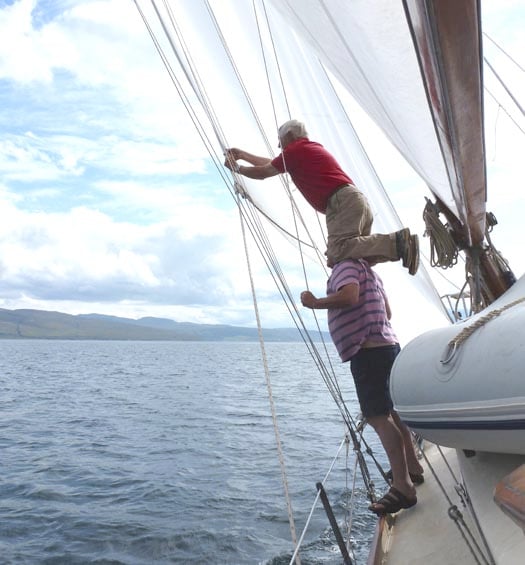
These guys need a GORB. The combined age of this acrobatic troupe is 148 years, with neither safety harness nor lifejacket in sight. Photo: W M Nixon
Another Plunge for Maguire in Hobart?
#sydneyhobart – Christmas partying is on hold for top ex-Pat sailor Gordon Maguire as he and his crew make the final preparations to defend their place as champions in the premier offshore event in the Southern Hemisphere, the annual Rolex Sydney-Hobart Race.
Since its inauguration in 1945, the 628 mile classic to Tasmania across the challenging Bass Strait has started every year on St Stephens Day. However, in the early events, going off on the thrash to Hobart was considered an integral part of the Christmas festivities – it wasn't unknown for crews to be still partying even as they raced down Sydney Harbour towards open water.
But these days, with an elite lineup next Wednesday of some of the greatest offshore racing boats in the world, it is incumbent on all crews to be hyper-fit and well able for anything the sea can throw at them. If you're not - as has been shown in some of the storm-battered stagings of this great race - the result could be fatalities.
The worst storm of all came in the 1998 race, and the helicopter vids of that would test the offshore racing enthusiasm of even the keenest hardcase viewer. It's quite something to witness 80ft plus Maxis racing along like over-pressed dinghies out in the open water of the Bass Strait. But when you see one of these biggies leap out of the top of a wave and crash into the sea beyond with the huge rig shuddering like a leaf, then you get some idea of what the Sydney-Hobart mystique is all about.
For anyone prone to seasickness, Christmas dinner the day before might be no more than boiled whitefish and mashed potatoes. And out there in the bash southward down the coast of New South Wales, it's a rough world in every sense, with sympathy is in short supply. Last year one of the participants was the famous American vintage 48-footer Carina, built 1969. Having won the 2010 Bermuda Race, she then won her class in the 2011 Fastnet Race and placed fifth overall, an extraordinary achivement. So then the junior members of the crew simply sailed her out to Sydney straight across the Atlantic and the Pacific in time for the 2011 Hobart Race. When the senior crew members joined up, they hadn't been offshore since the Fastnet, and weren't as battle-hardened as the young toughs. So on the second night, slugging into a southerly buster, some very distinguished American yachtsmen were not at all well. Sympathy? No chance. The heartless young Turks simply let the world know that "The Roar of the Dinosaur was Heard Across the Valley of the Lee Rail..... "
For Gordon Maguire and the crew of the 63ft Loki, as defending champions they've everything to lose next week. But the boat is in top form – they lead the points table in the current Australian offshore championship - and with Maguire as sailing master, owner Stephen Ainsworth has one very special talent.
When Loki won the race last year, it was Ainsworth's 14th attempt. But Gordon Maguire won at his very first shot, back in 1991 when he was helming, with Harold Cudmore as boat captain, aboard the 41ft Atara. She was part of the three boat Irish team that stormed Australian sailing to win the Southern Cross series, which culminated in the Hobart race where the Cudmore/Maguire victory sealed the team win.
For next Wednesday's start, the forecast is for fresh sou'easterlies initially, then going east and even northeast before a new westerly sets in late Friday. With plenty of wind expected in the mixture, this pattern suggests that one of the hundred footers – there are four of them in the race – might get to Hobart in a new record time.
As all the biggies are owned and sailed by tough cookies sent out by Central Casting to be the very personification of over-the-top Australian exuberance, the battle of the giants for line honours inevitably draws the initial headlines, and it has added Irish interest as Offaly-born Adrienne Cahalan is navigator (her 21st Sydney-Hobart) on one of the most fancied hundred footers, Wild Oats. But the Tattersall Cup for the overall IRC victor is one of Australia's most revered sporting trophies, and as the big boat brouhaha settles, all attention in Hobart will focus on who is coming up the Derwent towards the finish with a chance of snatching the lead.
When Loki was confirmed as overall winner by 50 minutes in the last days of 2011, the real party started, and Gordon Maguire was ceremonially thrown into the harbour. He didn't mind that at all. He soon texted the folks at home to tell them that the water in Hobart was nowhere near as cold as the water up at Lambay had been back in August 2011, when he'd to go over the side to clear a lobster pot line from the propellers of his father Neville's motor-cruiser.
MORE CLASSIC BOATS FROM PORTRUSH
Our story last week about the Howth 17 Deilginis, built by James Kelly of Portrush in 1907 and restored this year with a new deck by Rui Ferreira of Ballydehob, has rung the bell for classic boat enthusiasts. That fine north coast sailor Robin Ruddock (who restored Wallace Clark's 36ft yawl Wild Goose after she'd suffered the indignity of spending a month under water at the mouth of the River Bann) plays a key role in keeping the Kelly memory alive, for there's no boat building at all these day in Portrush.
But when he was at his busiest, between the 1890s and the 1930s, James Kelly made Portrush a remarkable centre for the master shipwright's art and craft. Initially, he set out to build Drontheims. those elegant double-ended clinker-built 26 footers which were derived from boats imported from the Norwegian port of Trondheim, and were developed along the north coast as multi-purpose vessels. As most of them were built at Greencastle in Donegal, they became known as the Greencastle yawls, but other builders right along the north coast produced their own local variants, and James Kelly was so good at it that he soon had Portrush rivalling Greencastle as a boat-building centre.
But his reputation soon spread beyond the Drontheims, and during the 1890s he started building yachts, two of the most noted being the 9-tonner Saiph in 1897, and the 15-tonner Yucca in 1898. They were both designed by their owner, Howard Sinclair, a Belfast doctor who was an early cruising pioneer – in 1896 he was the first winner of the Challenge Cup of the Cruising Club (later the Royal Cruising Club) for a round Ireland venture with his 5-tonner Brenda, built by Hilditch of Carrickfergus. He was awarded the cup again in both 1896 and '97, for cruises to the Outer Hebrides and the Orkneys with Saiph and Yucca.
James Kelly cheerfully admitted that there was much better money in yacht building than in the construction of fishing boats, but he kept the fishing boat side of his business going, albeit on the back burner. By the early 1900s, however, he was right up there with the leading yacht builders in Ireland, and two of the new Dublin Bay 21s came out of the Kelly yard in 1903-04, Garavoge and Oola.
Thanks to Hugh McGrattan of Portrush, we have this eloquent photo of Garavoge just before her launch in 1903. There is an entire universe in this portrait of the elegant yacht and the crowd about her, with the owner and his friends, and the rightly proud workforce and their friends, all basking in the goodwill at the height of the Edwardian era. And the new Mylne-designed boat looks marvellous – if anyone ever asks you what a classic counter stern should really look like, you couldn't do better than this.
In her long career, one of Garavoge's owners was Gordon Campbell, Lord Glenavy – he was a real mover and shaker in Dublin Bay sailing as he was also active in the Water Wags and the Mermaids, and in 1934 it was his suggestion which led eventually to the Dublin Bay 24 class.
His son was Patrick Campbell the humorist and TV personality, who wrote of sailing in Garavoge – his account of returning from Wicklow Regatta in fog is a gem. When he was told in 1978 that the Twenty-Ones were still active and that Garavoge was still with them, he expressed surprise, saying he thought that by that time "the better bits of Garavaoge would have long since been turned into a dog kennel, or at the most optimistic level, a sturdy home for hens".
With the remains of the seven boats of the Dublin Bay Twenty-One class now mouldering in a farmyard in County Wicklow, Campbell's drollery has become all too true. After he'd seen the photo last week of the Kelly-built 1907 classic Deiliginis so beautifully restored, Robin Ruddock asked what had become of Garavoge. It would have been too cruel to tell him.
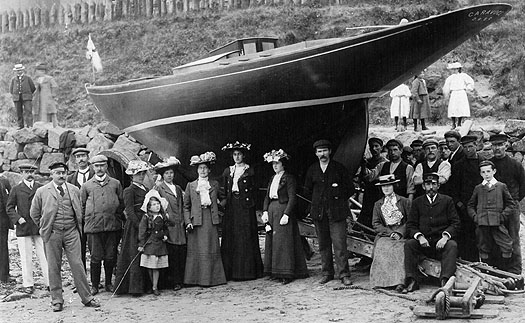
Launching day for the Dublin Bay Twenty-One Garavoge at Portrush in 1903. The builder James Kelly is believed to be beside the rudder. Photo courtesy Hugh McGrattan
THE YACHT DESIGNER IN THE CELLAR
My appreciation here a fortnight ago of the late Mike Balmforth and his remarkable career in many branches of the marine industry has started a line of chat in some nautical forums about the T24, T27 and T31. It was one of Mike's first jobs in the boat business, building these performance cruisers with Chris Perfect in Chichester, and mention of the marque has revealed a network of Guy Thomson fans.
Guy Thompson was a leading East Anglian offshore racing enthusiast during the 1940s, 50s and 60s who worked for the Bank of England at their massive headquarters in Threadneedle Street. But he was also a very talented and innovative amateur yacht designer, so much so that a succession of boats he designed for himself – all called Calliope – were always in the EAORA prize list. Thus it's perhaps not strictly true to say that he worked for the Bank of England. He was employed by them. But his real work was down in the cellars, in an unused room he discovered which, over the years, he turned into a proper little secret yacht design office.
We shouldn't be surprised by this – after all, Kenneth Grahame, for many years the Secretary of the Bank of England, also found the time to write the children's classic The Wind in the Willows.
Nevertheless, Guy Thompson's parallel career as a part-time yacht designer was in a league of its own, and when he retired from the Bank, he left behind this secret room stacked to the ceilings with yacht designs and drawings.
Maybe he was too much of a free-thinker to have functioned as a professional designer. As it was, his unique position allowed him to be way ahead of the posse, and in the 1960s when noted East Anglian dinghy racer Dick Pitcher (he was an ace in the Flyng Dutchman) decided he wanted a small performance cruiser, he went to Guy Thompson.
Pitcher's specification was for five berths, full standing headroom, excellent all round performance, and all within 24ft LOA. The result was a little boat called Goosander with which Pitcher won everything about him in 1967, and soon the production version, the T24, was on sale.
As the plans show, there was so much good sense and innovative thinking in the T24 that it's a pity Guy Thompson wasn't designing full time – many yacht designs at this period were dull and unimaginative in the extreme. But the T24 hit the button for those who could think outside the box, and one of the first in Ireland was Kilderkin for Lance McMullen of Dun Laoghaire. His previous boat had been the 36ft ex-6 Metre Rainbow, yet his new much smaller boat was an improvement in almost every way.
Sadly, in the 1960s some of the new GRP production boats were built with wooden decks and coachroofs on the fiberglass hull, and the T24 was one of them. It didn't take long before the clashing behavioural characteristics of the two materials caused problems, and a later owner of Kilderkin recalls her as leaking along much of the hull/deck join.
But like all T24 owners, he fondly recalls her gallant performance, particularly to windward in a breeze. When you think of what some of the boring standard boats of the 1960s were like, you can appreciate why the astonishing little T24 was like a breath of fresh air. And our friends on the forum assure us that a reasonably able amateur handyman with time available can fix those deck leaks.

The boat designed in a cellar in the Bank of England. Guy Thompson's T 24 had the accommodation and performance of many boats half as big again. And don't forget if someone is taking a photo of your boat, always sit down - otherwise she'll look even smaller than she is already
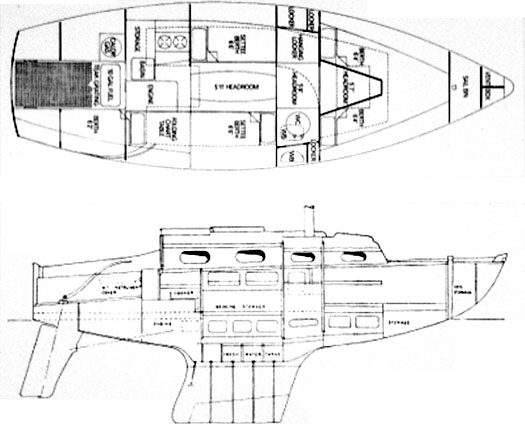
If you want to see how five berths, full standing headroom and a scintillating performance can be fitted into a hull just 24ft LOA, take the time to study these plans of the T24.
We Have a Gold Medallist for a New Olympic Category
#olympic – If there was an Olympic category for Nasty Tricks, there'd have been a runaway Gold Medal for whoever anonymously revealed – just as London 2012 was getting under way – that red hot Irish sailing prospect Peter O'Leary had infringed regulations at the 2008 Olympics by betting successfully on the outcome of the Star Class, in which he'd been a participant, but had failed to make the cut for the medal races.
Since 2008, O'Leary had upped his game in major style. With David Burrows of Malahide as crew, and a new state-of-the-art Star class boat as his 2012 campaign accelerated, he was very much in the hunt with the Silver Medal at the class's huge Bacardi Cup regatta in Miami in March. Then they won Gold in the pre-Olympic event at Weymouth, the Sail for Gold regatta in June.
A month later, when everything was looking good in the final couple of days countdown to the big one for Ireland's medal prospects, both in the Star class, and with Annalise Murphy in the Women's Laser Radials, the anonymous bomber struck. There was no time for the International Olympic Committee to make any sort of investigation of the Beijing bet allegations, let alone a definitive one. So they declared the matter sub judice until after the games were over, and the great regatta went ahead with O'Leary a participant, albeit a wounded one.
For although the IOC may have put the matter to one side, this didn't oblige everyone else to do so. Had the O'Leary/Burrows crew fulfilled their previous form, and their good showing in the opening races of the Olympics, we can be sure the matter would have raced to the top of the news agenda if they'd been within shouting distance of one of the top prizes. But the strain of all the wrong sort of attention showed, and the Irish crew slipped down the rankings. Though they qualified for the medal races, they finished a lowly tenth of the ten boats, so the Beijing betting controversy was no longer relevant.
Now the matter has been closed at official level with a statement on Tuesday from the International Olympic Committee at their end-of-year conference. They have let O'Leary off with a warning, as they've found "no proof of any match-fixing" and that O'Leary "was not fully aware" in 2008 of a new protocol against participants betting on Olympic results.
So a nuclear cataclysm has been reduced to a storm in a teacup. But make no mistake, at the time this was nuclear and then some. The entire Irish Olympic sailing project was knocked off balance right at the start of the Games. The ill effects on the O'Leary/Burrows crew were obvious. But we can only guess at the collateral damage to Annalise Murphy as she became the focus of all Ireland's Olympic sailing hopes, under severe stress as her initial excellent prospects for Gold slipped to a fourth at the finish.
In the end, it was just completely and utterly sad.
WHALE'S EYE VIEW

HE'S BEHIND YOU! The Christmas panto season comes early to West Cork on Sunday December 2nd as a humpback whale take a mighty leap behind Wave Chieftain, whose squad of whale-watchers look steadily the other way. Photo: Simon Duggan/Provision
Whales are brainy, and they've a sense of humour too. The thought sprang irresistibly to mind when Monday morning's papers carried this wonderful photo, taken on Sunday off Baltimore at the precise moment a humpback whale did a mighty leap out of the sea behind a ship's complement of earnest whale watchers aboard the dive boat Wave Chieftain, with every last one of them looking the other way.
They're allowed a certain amount of watchfulness relaxation aboard Jerry Smith's Wave Chieftain now and again, as they've shown that when it's a matter of life and death, they can conduct successful sea searches against all the odds. Back in August 2011, Wave Chieftain found the five missing crewmembers from the capsized Rambler 100 with perhaps only minutes to spare before an incident became a tragedy.
Whatever, this is some whale – we'd thought Fungie at Dingle was impressive, but a humpback is in a different league altogether. Nevertheless if you're near Fungie and he's in a jumping mood, it's more than enough to be going along with. After the 1995 Dun Laoghaire to Dingle Race we stayed on for a few days to savour the many joys of West Kerry, and one afternoon with what seemed like a million people on board, we went out in the sunshine to the harbour mouth to see the mighty dolphin.
The crowd aboard included waifs and strays from other boats which had raced to Dingle, so you can guess that the coherence of the shared thoughts and recollections was uneven at best. But the fact is, we returned to port with everyone convinced that Fungie had jumped clean over the boat, going neatly between the mast and the backstay.
There'd been a complete carnival atmosphere out at the Dingle entrance, with the fleet of spectator boats whirling every which way as the mighty dolphin leapt among them. People were jumping overboard to join him, including Johnny Rooney from our boat, and how somebody wasn't decapitated in the threshing of propellers heaven only knows, but the atmosphere was such that you felt you could walk on water – that's the effect Fungie can have.
Earlier in 1995, we'd a rather more scary encounter with a whale while sailing out to Spain (a busy year, was 1995), trundling along minding our own business and not looking for whales at all. Snug behind the sprayhood in the cockpit on a damp evening while the Autohelm did all the work, the mate and I were having a mug of tea with the essential fig rolls and chocolate digestives when we suddenly realised we were sailing past an enormous whale which was parallel to us, and only about ten feet away.
She really went on and on and on, she was enormous – and we soon knew it was a she, for she was keeping herself between us and her calf. If the gap had been any less, a swish of her tail would have ended for ever our enjoyment of Barry's tea with the fig rolls and the chocolate digestives.
Out in Spain, we met up with some experienced ocean sailors, and I recounted this experience to one who had in his time seen a blue whale, the biggest of all. He upset me with his response. "I don't believe you," said he. "But I swear it's true" said I, "we really did get close to this whale that was pushing towards a hundred feet in length". "Of course you did" said he. "I accept you saw this whale, and I know that a size like that is within the realms of possibility. But I don't believe for a minute that you two were drinking tea at that time of day".
MIKE BALMFORTH
Mike Balmforth had not been in good health for years, but it was still a shock to get the message on Sunday that this stalwart of the maritime world had died peacefully that morning after a sudden deterioration in his condition. He was busy about the world of boats and maritime communications to the very end, and only three days before his death I'd received the usual efficient Balmforth email in response to a query I'd sent him about a boat I'd glimpsed while cruising in Scotland in August.
That was the Balmforth way – do the job without making a song and dance about it. His achievements in many areas were prodigious, yet unlike many people whose activities cover a broad area, he was the most low-key operator you could meet – he simply didn't have the time or inclination to be flamboyant. Nor was he noisily energetic, but he got things done.
Most recently, he has achieved further acclaim with his comprehensive Cruising Companion to sailing the Irish coast, a continuation of the concept he developed to cover the west coast of Scotland in a way that puts interesting flesh on the bare bones of the basic sailing directions. That he made such a good job of it was because of his great experience in cruising, and in so many areas of the marine industry and the world of boats and sailing, combined with his wide knowledge in the demanding sphere of maritime publishing.
But unlike many writers, he was equally good in administration and management. I first became aware of this back in the early 1960s when he was Honorary Secretary of Queens Universty SC in Belfast. The rest of us simply wanted to get on with college sailing and having a good time, but Mike was the man who did the work behind the scenes to ensure that grants for new boats were increased and the money used to best effect.
Even in his schooldays he played a key role in the junior section at Strangford Lough YC at Whiterock, so as he was active in Scotland in many positions of maritime significance at the time of his death, his effective input into maritime administration spans more than half a century. As too does his involvement with the practical side of boats and boatbuilding - with his father (who was to die all too young), Mike had built one of the first Enterprise dinghies to be seen in Strangford Lough, thus when he went up to Queens his technical knowledge in commissioning new racing dinghies for the Sailing Club was invaluable.
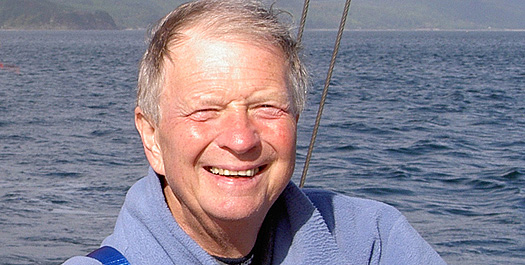
The late Mike Balmforth's last boat, the Dawn 39 Greenheart completed in his back garden to his own specifications, is a superb cruising vessel, a fine expression of his special skills as a sailor and maritime technician. Photo: W M Nixon
He was to be involved in a number of areas both geographically and career-wise before settling in Scotland. He built production cruisers – the T24, T27 and T31 – with Chris Perfect's company in the south of England on the shores of Chichester Harbour. He then became a staffer with Yachting Monthly in London, rising to be Deputy Editor. His sailing horizons expanded – he was a regular participant in offshore racing in many areas including the Fastnet Race, and he honed his cruising skills. Then he really began to find his feet as a partner with Caledonian Yacht Services in Glasgow, an all-embracing organization based on yacht brokerage but busy in most areas of boats and boat-building.
With his marriage to Alison, the doctor daughter of a boatbuilder in Argyllshire, his position in Scotland was complete, yet he always retained close links to Ireland. However, the west coast of Scotland and particularly the Clyde area was where he was busiest, and he was soon much involved with that large and very effective organization the Clyde Cruising Club, while at the same time developing his business interests in several sections of the marine industry.
He also oversaw the completion of several cruising boats for his own use, starting with bare hulls and installing functional yet attractive accommodation, and deck layouts which worked very well, both based on his intelligent experience of seafaring. With craft such as the very special Ruffian 8.5 Sgeir Bhan, and two boats of the David Alan-Williams designed Dawn 39 class, Mike had boats which he could race and cruise in the case of the Ruffian 8.5, and cruise extensively with the Dawn 39s.
The first Dawn 39 he owned in partnership, the second one was his true dreamship, the handsome Greenheart which was completed from the bare mouldings in his back garden on the shores of the Clyde. Aboard Greenheart, he and Alison and their family and friends cruised happily to many places both near and far, and she was and is one of the most admired cruising boats afloat.
Throughout this time he was keeping up a formidable pace of work, yet as his worsening heart condition increasingly restricted the amount of physical work he could undertake, he simply transferred his abundant energies and very active mind to developing Clyde Marine Press. His renowned managerial and administrative ability and skill in committee work led to his appointment to council or committee on an increasing number of public bodies and national associations, while his knowledgeable collation of pilotage information saw him being elected as a Fellow of the Royal Institute of Navigation.
All this was achieved despite deteriorating health which eventually required quadruple heart surgery, and resulted in complications which meant that for the final years of his life, he required kidney dialysis every 48 hours. But he never complained, he kept up a work rate which was greater than that of many men in full health, and he and Alison continued with their busy and sociable life in Scotland and abroad.
This was complemented by a growing family – their two sailing sons Des and Robin both made them very happy grandparents. Mike Balmforth may have reached the three score years and ten, and his achievements are many, but his life has been cut short. He is much mourned by his many friends, and our heartfelt sympathy goes to Alison, and to Des and Robin and their families.
Sailing Needs Students
#icra – Like all consumer sports, sailing has taken something of a battering during the years of recession. The hard core dedicated enthusiasts are still actively involved, for nothing will deflect the true old salt from his or her destiny in and around boats. But many of those who took up sailing as just one of several lifestyle choices in the affluent times have faded away.
It's an ill wind that blows nobody any good. For anyone thinking of returning to sailing, or maybe getting involved for the first time, there's no better time than the present. The infrastructure is there to facilitate manageable expansion, and the people running the sport are keen to recruit newcomers, and bring back those who have strayed.
One area which is proving to be a happy hunting ground is university sailing. That said, it could equally be argued that it is the prodigious pace being set by the college matelots which is prodding the rest of the sailing community into positive action. Call it as you like, but the fact that the Galway University offshore racing boat was hailed as the latest ICRA Boat of the Year at the annual offshore racing conference last weekend struck us as being a very timely move.
We say that despite last week's column being prepared to wager a portion of the housekeeping on another boat altogether. We'll spare their blushes by not naming them, but up against the Galway juggernaut, all opposition fell astern. Team leader Cathal Clarke and his squad from the City of the Tribes put in a fantastic year with Martin Breen's Reflex 38, and as the entire crew were either students or recent graduates from NUIG, they provide the perfect personnel profile to make a healthy and useful longterm input into sailing.
Newly-elected ICRA Commodore Norbert Reilly of Howth is in no doubt that Irish sailing numbers have scope for expansion, and the 2013 programme will certainly keep those involved mighty busy. From early June until mid-July, you could be sailing with an offshore orientation almost continually, with the Dun Laoghaire to Dingle Race on 8th June, then on from Dingle to the ICRA Nationals round the corner in Tralee Bay from June 13th to 15th, then it's back to the south coast for the Sovereigns Cup at Kinsale from 26th to 29th June, followed by a return to the east coast with the Volvo Dun Laoghaire regatta from 11th to 14th July.
The scope which this programme provides for introducing new crews to the sport is enormous, and it will certainly sort out the faint-hearted. The real hard chaws meanwhile will barely be up to speed by mid-July - like the Galway college offshore racing team, they'll be thinking in terms of the Fastnet Race in August.
And for anyone who complains that this is an awful lot of sailing, the answer is usually a brusque comment that, once your time comes, you'll not be sailing for a very long time indeed. Thus our thoughts this weekend are with Cork sailor Kieran Walsh. He's working in Dubai, but this week has been sailing as crew aboard Doug Worrall's First 36.7 Shahrazad in the annual Dubai to Muscat race, a three day RORC event.
You need to do such things to offset the rigours of working in the desert. But they did rather better than that. They won. It's a tough old life, but somebody has to do it.
THE GAFFER OF THE GAFFERS
Tim Magennis, newly-elected President of the Dublin Bay Old Gaffers Association, was in fine form on Tuesday night as he welcomed an eclectic and enthusiastic audience to Sean Cullen's presentation about INFOMAR in Poolbeg Y&BC under the auspices of the Old Gaffers. INFOMAR is the twenty year programme - currently in its twelfth year – to survey the seabed around Ireland and the adjacent ocean in unprecedented detail, and Sean Cullen has proven such a dab hand in charge of the survey ship that he is consulted by other nations keen to get in on the acquisition of knowledge of the deep.
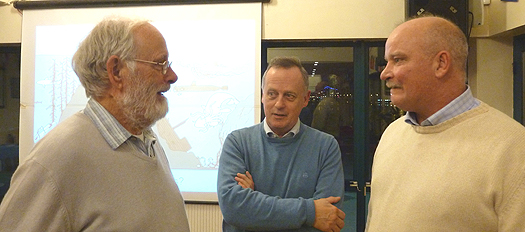
The Boyd men of Poolbeg. Owners of Herbert Boyd-designed classics at the OGA gathering in Poolbeg Y&BC are (left to right) Tim Magennis (Marguerite, 1894), Ian Malcolm (Aura, 1898) and Sean Cullen (Eithne, 1893). Photo: W M Nixon
As for Tim Magennis, it made for a high profile week, as he had something of a starring role on Thursday night in TG4's extensive filmed documentary about Erskine Childers. Most appropriately, the guru of the gaffers was involved on the television programme to explain the skills involved in sailing the engineless Asgard to Howth with the cargo of guns in July 1914, and especially to highlight the sheer brilliance with which Molly Childers helmed Asgard to bring her gently alongside the pier, neatly head to wind in a strong nor'wester, a formidable display of seamanship.
Sean Cullen's work in surveying the seas of Ireland and their hidden depths is fascinating. And it's a bit scary to discover just how much is still to be discovered, when we tend to assume every major hazard has been known about and on the charts for decades. The most striking example of this is a previously unknown pinnacle rock a few miles westward of Slyne Head. There's 12 metres over it, which explains why it has gone undetected for so long. But as the rock is a bit like St Patrick's Cathedral plonked down in the middle of an otherwise fairly flat bit of the seabed, until it was discovered it represented a potential danger for any supertankers which happened to be proceeding up the west coast of Ireland.
OLD BOATS ON A COLD COLD SEA
The gaff enthusiasts of Dublin Bay are gearing themselves up to welcome fellow gaffers at the June Bank Holiday weekend next year, as Dublin Bay will be an important focal point in the Irish Sea for the rolling cruise-in-company with which the many branches of the OGA will be celebrating its Golden Jubilee.
Of course, for some folk in Ireland, making a song and dance about preserving gaff rig seems decidedly weird. It's not that this select group have rejected gaff rig entirely. On the contrary, as far as the Howth 17s are concerned, it never went away. They still sail their boats rigged exactly as they were designed in 1898 by Herbert Boyd, and they see little reason to change.
The OGA gathering in Poolbeg provided a rare opportunity for the owner-skippers of three different Herbert Boyd-designed gaff classics to get together. Sean Cullen owns the 25ft Eithne, the first Boyd yacht, built by Boyd himself in the boathouse at Howth House in 1893. Tim Magennis owns the 24ft Marguerite (that was Marguerite in the early part of the Childers film), which was built by Jack Wellington, a sailor/boatbuilder from Scandinavia who somehow acquired the name Wellington when he settled in Malahide. And Ian Malcolm owns the Howth 17 Aura, one of the original batch of five Howth 17s which were built by John Hilditch of Carrickfergus in 1898, and sailed home to Howth by their owners.
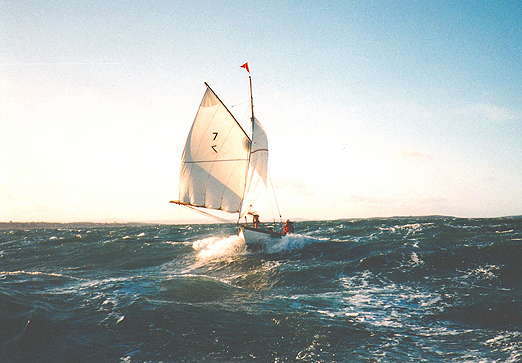
Baby, it's cold outside.... Ian Malcolm's Howth 17 Aura sailing from Carrickfergus to Howth on the evening of April 15th 1998 to celebrate the Centenary of the first five boats of the class making the same delivery passage in April 1898. The land just visible is the County Down coast on the left, the Antrim coast in the distance, and Copeland Island on the right. Photo: Damien Cronin
That inaugural voyage of the Howth 17s was replicated for the Class's Centenary in April 1998 in a strong and very cold nor'easterly wind. At least it was a fair wind, but conditions were otherwise Arctic. As one of those who took part, Ian Malcolm, was uniquely qualified on Tuesday night to tell the OGA enthusiasts about what is involved in sailing vintage gaff rigged yachts from Belfast Lough to Dublin Bay, which will be part of the Golden Jubilee programme.
But at least they'll be doing it in June rather than April, and they'll be doing it in boats with lids rather than a Howth 17, which passes the Number One test for a genuine classic – they're diabolically uncomfortable boats to crew aboard, even in pleasant conditions. In April 1998 with temperatures plunging towards freezing point during the overnight 85 mile sail, they were torture chambers, but the crews didn't notice - they were completely numb with cold......
Shining Thoughts in the Marble City
#icra – The Irish Cruiser Racing Association's (ICRA) annual conference today is in a place better known for its hurling prowess. But over the years Kilkenny has proven a popular venue for the meeting - ICRA has an understandable fondness for the Marble City, for it was here that Fintan Cairns, the late Jim Donegan, and other far-sighted sailing folk brought this most successful organisation into being ten years ago.
At the time, some old stick-in-the-muds (this columnist included) tended to the view that offshore racing organizations should be related to specific sea areas such as the Irish Sea or the North Channel. We were completely and utterly wrong. ICRA took off like a rocket, and has been flying ever since, with the canny Denis Kiely running the back office for the complex number crunching which is essential when you're coordinating racing for boats of many types and sizes.
The annual ICRA Nationals, a crazy new-fangled notion when it was introduced from the beginning as central to the organisation's purpose, has become such a prestigious happening that clubs compete to be selected to stage it. 2012's in Howth in May was a classic, with 115 starters enjoying the last of the Springtime's good weather to have some magnificent racing with a fleet size that other forms of sailing would die for.
Class Zero saw an overall points tie between Anthony O'Leary's Ker 39 Antix and Richard Fildes' Corby 37 Impetuous from South Wales, which the Cork boat won on the countback. Class 1 also went to Cork in the form of the J/109 Jelly Baby (Ian Nagle & Paul O'Malley), Class 2 went to the North Wales/Dublin Bay skipper Nigel Biggs with Checkmate XV, Class 3 went to Cork and George Kenefick's classic Quarter Tonner Tiger, and Class 4 went to Toy Yot from Malahide, an attractive Everitt 22 which had been taken over as a derelict in Malahide Boatyard last winter by a team of marine industry specialists around Malahide Marina headed by Stephen Mullaney. Though the only significant new item to go into the project was a suit of sails from the local Philip Watson loft, the input of much spare time elbow grease resulted in a successful campaign, a lesson for our times.
The ICRA Nationals 2013 will be staged in Tralee with Brian O'Sullivan in charge, and he will be outlining the developing programme at today's gathering. It's a case of shaping the event to suit current economic realities. Even a high flying group like ICRA can feel the effects of the recession as keenly as everyone else, and one of the disappointments of 2012 was having to acknowledge that the resources simply weren't available to mount a defence of the biennial international Commodore's Cup, which the Ireland Team organised by ICRA had won in convincing style in 2010. ICRA Commodore Barry Rose of Cork, who had been the pace-setting manager of the 2010 campaign, explored every possible option to put a campaign in place for 2012, but he made the right call when he declared it a non-runner, concentrating resources instead on serving the sport at home.
One particularly encouraging feature of the past season has been the emergence of strong University crews on the offshore scene. Back in June in the Round Ireland Race, Galway University were right in the hunt with their chartered Reflex 38, and they won their class and placed sixth overall in an international fleet. Buoyed by this success, they head into 2013 with an even more ambitious programme which will include the Fastnet.
At the end of October, the Student Yachting Worlds in France - a classic inshore-offshore event - saw a runaway overall win for Ireland, represented by UCD with Cathal Leigh-Doyle as Captain and Aidan McLaverty as skipper, a result which provides the bonus of Ireland being allocated two team places in the 2013 Worlds.
The UCD campaign was such a good model of its kind that the team will be giving a presentation at today's Kilkenny conference to outline the basics of their approach. And Ireland's own international offshore sailing superstar, Damian Foxall, will also be giving a presentation about being the First Mate aboard Franck Cammas' Groupama, overall winner of the Volvo World Race which concluded in style in Galway.
Barry Rose will be standing down as Commodore with the organisation in good heart, and ICRA being run in a style reminscent of the Government of China, we know already that he will be succeeded by Nobby Reilly of Howth, whose enthusiasm for campaigning his Mills 37 Crazy Horse wth co-owner Alan Chambers at locations on all coasts provides the leadership by example on which sailing organisations thrive.
And then the business will be concluded with the final stages of the voting for the ICRA Boat of the Year. We've a feeling here that it will be Jelly Baby (Ian Nagle and Paul O'Malley). This J/109 is already 2012's Boat of the Year at the Royal Cork, and even with the competition made nationwide, she still fits perfectly into the slot of top boat for these straitened times.
JOHN TWOMEY IS THE MAN FOR THE JOB
We learned last weekend that Irish politics is only in its infancy compared to the workings of the International Sailing Federation as manifested at its annual conference in Dun Laoghaire from November 1st to 11th.
Having 700 delegates certainly creates a steamy brew of intrigue. The big issue was whether it was to be kite-surfing or wind-surfing, or some mixture of both, for inclusion in the 2016 Olympics. Kite-surfing on its own had been voted in to replace windsurfing by the ISAF Council at its meeting in May by a majority of just two votes. But this caused so much grief that the ISAF Events Committee put through a motion last week for a sharing of the Rio de Janeiro slot by both kites and windsurfers.
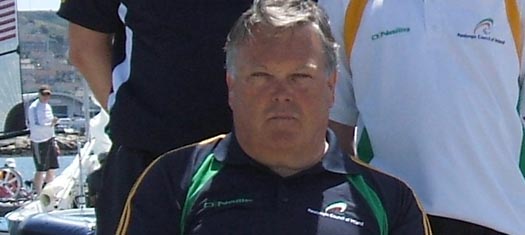
John Twomey brings an unmatched Paralympic participation record to his new role as President of the International Association for Disabled Sailing.
When this reached the Council last Saturday, it wasn't ratified, as they needed a majority of 75% to re-visit a previous decision, and that majority wasn't forthcoming. But the canny wind-surfers still had a secret weapon. The massive AGM with all delegates at the end of the conference can consider all decisions made by the Council, and rejecting them only needs a simple majority.
This particular bazooka was brought into play on Sunday, and the Council's Maytime decision was blown clean out of the water. Windsurfing is back on top. The kiters won't be in the frame at all in Rio. And windsurfers who had "gone over to the other side" by buying kiting equipment since May's decision are now doubly bruised – they've sent money down the drain, and staunch windsurfers regard them as turncoats.
But happily the conference produced a breath of fresh air with the news that John Twomey of Kinsale, Ireland's most dedicated paralympian who has done ten games in both athletics and sailing, has been elected to a four year term as President of the International Association for Disabled Sailing. No better man.
A GREAT MAKING OF SAILING BOOKS
Seems like the launchings of new sailing and maritime books is getting to be like the Number 33 bus. You wait for ever (in the rain of course), and then two come along at once. Last Wednesday provided nautical bibliophiles with an insoluble dilemma. Pete Hogan's lovely new "Log of the Molly B" was being launched south of the Liffey in the Davenport Hotel at 1800 hrs by Conor Brady, former editor of The Irish Times. And north of the river - at precisely the same time in the Customs House - they'd two Government Ministers on hand to launch the hefty new book about the wrecks of Ireland as measured electronically by the new survey ship which is skippered by Sean Cullen.
The Log of the Molly B is proving to be a cult hit, plus it has the virtue of solving Christmas present problems at a stroke, so publishers Liffey Press found themselves in the happy position of running out of copies to sell. Yet people kept waving money at them and they soon had a paid-for list for postage next day.
It was an intriguing evening, with sea-minded alumni of the Cistercian College Roscrea present in strength. CCR is about as far from the sea as you can get in Ireland, but Pete Hogan went there, and so too did Conor Brady, hence the unlikely linkup between the editor of a national newspaper and the reclusive artist-sailor whose talents have proven ideal to producing a beautifully illustrated gem of writing. It seems that though there are Cistercian Monasteries throughout the world, the only one with a school attached is in Roscrea, which might explain how this unique book came to be created.
There's a chance of a replay of the wrecks book launch next Tuesday (November 20th) at 8.0 pm in Poolbeg Y & BC when the Dublin Bay Old Gaffers Association are hosting a talk by Sean Cullen about Captain Bligh, and as a sideline the wrecks book will be on sale.
After the mutiny on the Bounty and Bligh's extraordinary voyage to survival on the ship's boat, the Captain was sent to Dublin for a while to get him out of the limelight, and during his time here he was advising on the development of Dublin Port. So totally did this get Bligh out of the picture for a few years that a recently published biography of him makes no reference to it. But he was here for sure, and he made creative suggestions for the development of Dublin port which continue to benefit the city today.
As for the Dublin Bay Old Gaffers Association, they recently elected the irrepressible Tim Magennis as their President, nicely in time for the Golden Jubilee next year of the OGA. A highlight of the celebrations will be a massive assembly of gaffers and classics in Dublin Bay in June, and Tim will be the ideal man to lead it – he owns the 1894 gaffer Marguerite, designed by Herbert Boyd of Howth and built by Jack Wellington in Malahide, and back in the 1960s he sailed round the world in the Colin Archer ketch Sandefjord skippered by Pat Cullen, whose son Sean is next Tuesday's lecturer.
DUBLIN BAY – CRADLE OF YACHT RACING
Hal Sisk has been at it again. The polymathic yachting historian must have barely paused for breath after masterminding the magisterial book about the Scottish designer G L Watson (published last February) before he got to thinking that the ISAF Conference in Dun Laoghaire would provide the perfect opportunity to remind global sailing's administrators that the basics of modern yacht racing management were laid down on Dublin Bay by the moving spirits in the Royal Alfred Yacht Club, which was founded in 1870.

Don't forget to scald the pot, and use only the best Darjeeling. One of the evocative photos of Dublin Bay sailing by Paget Haffield which are almost a distraction from Hal Sisk's learned discussion of Dun Laoghaire's key role in the creation of modern yacht racing in his new publication, Dublin Bay – The Cradle of Yacht Racing. These two classic sportsmen, complete with Meerschaum pipes, are aboard a becalmed Dublin Bay 25 at the height of the Edwardian era.
The trouble is that over the years, Hal has accumulated so much in the way of historical material that, even more than the rest of us, he needs an editor-in-chief to oversee his every creative move, otherwise we get swamped in the outpouring of information.
But the fact is, Dublin Bay did do the groundwork, but the newly formed Yacht Racing Association took up the Royal Alfred framework so totally that its origins in Dublin Bay were quickly forgotten everywhere else except in Dublin bay, and even then, only by a few. Then too, the Americans tend to think that the basics of the yacht racing rules were almost entirely formulated by Harold S Vanderbilt, and a quaint little club in Ireland would have little chance of successfully staking its claim in the origination stakes when set against the might of the Vanderbilts.
But the deadline of the imminent arrival of the ISAF express meant that Hal and his team just had to get a 50-page book together in jig time. "Dublin Bay-The Cradle of Yacht Racing" was published by Peggy Bawn Press at the end of October, and it's persuasive in its arguments. But when so much pure gold is there to be mined in historic photos, it's easy to be distracted. Hal has access to the glass plate collection of 300 sailing photos taken around Dublin Bay by one Paget Haffield between 1888 and 1914, and the book is dominated by a selection of them. The publishing team just couldn't resist giving a whole page to this image of two very recognisably Dublin sailing types clowning about with the preparation of tea in a complete and utter flat calm aboard a Dublin Bay 25 at the height of the Edwardian era. Do they look as though they care just who invented modern yacht racing?
Details on the book from peggybawnpress.com
Some Kite Flying for an Olympic Decision
#isaf – Kites or sailboards to be highlighted the most exciting form of sailing in the 2016 Olympics? If you're waiting for a clearcut answer from the continuing deliberations of the International Sailing Federation currently under way at their Annual Conference in Dun Laoghaire, then don't hold your breath.
Of all the world's capital cities, it is Dublin which is probably most aware of the growing impact of windsurfing and kite-surfing as hugely accessible forms of sailing which can take place off any beach. The greater city area is so well-endowed with miles of sand which can provide world class sport when the wind is up that, like it or not, we ordinary Dublin beach-walkers have become connoisseurs of the kiting versus sailboards controversy.
So although it may have discomfited many traditionally-minded national sailing establishments when sail-boarding became an Olympic sport, we Dubs were ahead of the posse. We were already looking to the next move. For we knew that, when surrounded by kitesurfers at choice venues like Dollymount Strand, sailboarders can seem like dowagers at a disco.
Thus with world sailing's sometimes embarrassing desire to appear hip, it was no surprise back in May when it was announced that, albeit by the narrowest of voting margins, kite-surfing would replace windsurfing at Rio in 2016. But while it may have been a definite decision, seems it wasn't a binding one. As far as we can gather, the relevant section of the current conference (which has 700 delegates in all) have changed their mind on the kiteboard/sailboard Olympic thing. Well, sort of.
Admittedly, we'd been looking forward to using a headline which leaps from the page, and would have become part of international sailing history. "The Dublin Decision" would certainly have wings. But we're currently looking at "The Irish Indecision". Or more accurately, "The Continental Compromise". Thanks to notable eloquence from the Continent in the form of delegates from Spain and Eastern Europe, we've ended up with a compromise which, at the time of writing, will see both windsurfing and kite-surfing at Rio, but put together in some mixture which won't involved an increase in sailing's Olympic medal allocation, which is always under scrutiny.
For that of course is the nub of the matter – the place of sailing in the Olympics. It's not an arena activity, and it's definitely a vehicle sport – that's two negatives. It could be that in the future, only the most minimal sailing vehicles will be accepted as sufficiently athletic for Olympic inclusion. Maybe some time we'll look back fondly to the days when boats were used in the Olympics, as kitesurfing in all its forms becomes the only Olympic sailing category.
Meanwhile, the Dun Laoghaire deliberations have been good for Ireland in that outgoing ISAF President Goran Petersson was lavish in his praise for the superb style of Dun Laoghaire's organisaton of the International Youth Worlds in July. But there was a poignant moment for the Irish sailing community at the World Sailors of the Year Awards at the Mansion House on Tuesday night.
Multiple Olympic Gold Medallist Ben Ainslie of Britain took the men's award, so no surprise there. But history was made with the Women's Award going to Lijia Xu of China for her Gold Medal in the Olympic Laser Radials. At the beginning of the sailing Olympics, she was scarcely figuring in the results at all, while Ireland's Annalise Murphy was piling on a substantial overall lead. But the Chinese sailor just got better and better, and was ahead when it mattered – at the finish of the last race. It was a mind-blowing lesson in sports psychology.
PETE HOGAN'S LOVELY BOOK
Much time may have passed since he did it, but nothing will ever change the fact that sailor/artist Pete Hogan of Dublin was the first Irishman to round Cape Horn single-handed, sailing his gallant little Tahiti ketch Molly B. He wrote about it at the time, but now with the mellowing of the years, he has written and illustrated a lovely book, The Log of the Molly B, which is being launched next Wednesday (November 14th) in the Davenport Hotel in Dublin's Merrion Street at 6.0pm by Conor Brady, former editor of The Irish Times.
There's an open invitation to the launching for the entire sailing community, and any other well-wishers too, for that matter. Of course there is an expectation that you'll feel moved to buy the book. But that's no hardship – it's a real page turner, a joy to have and to hold and to read, beautifully produced by Liffey Press, and at €19.95 it's priced just right.
There is of course much more to it than the rounding of the Horn. The Log of the Molly B perfectly evokes the mood of the 1980s, and an approach to seafaring and ocean wandering which harked back to the era of the great individualists and legends of the sea, rather than being overpowered by the shiny new era of advanced marine electronics and high tech sails and rig, set in a framework dominated by official safety requirements.
So if you're in the mood to savour the atmosphere of a gaff rig gathering and celebrate the true spirit of voyaging, the Davenport next Wednesday at 6.0 pm is the place to be.

Creatures of the deep – a giant manta ray take flight past Pete Hogan's ketch Molly B, one of his many attractive illustrations for his new book "The Log of the Molly B".
THE JOY OF WORK (when others are doing it)
It was intriguing to note that one of the most popular features at the recent Hamburg Boat Show was a special active exhibition where damaged or worn glassfibre boats were given the complete restoration treatment during the course of the show.
It all sounds rather un-Germanic - you'd think their attitude would be that such things should be done by professionals behind closed doors. And heaven only knows what the front-line exhibitors showing shiny new boats made of the fact that so much attention was being given to scruffy old ones. But it was a runaway success, the DIY brigade loved it and learned much from it, and of course for the ordinary Joes and Josephines who wouldn't dream of doing their own maintenance and repair tasks, there was the eternal fascination of watching work in progress.
Those of us who were lucky enough to be allowed in to the workshop at Collins Barracks when John Kearon and his team were conserving Asgard could only reflect that it was a pity that when the historic old ketch was finally put on display, it would be as a static exhibit. In many ways it was more interesting when the work was in progress, not least when the team of voluntary riggers from Howth, led by Pat Murphy and Neville Maguire, were on the job to provide enough in the way of spars and rigging to give a better impression of what Asgard was like in her heyday.
However, the work has been so well done that even with the old girl now totally at rest and on display, it's a very complete exhibition, encompassing the development of yacht design and building with an insight into a very complex period in Irish history.
With a well-chosen selection of photos, the human interest shines through in unexpected ways. We already knew that Erskine Childers' friend and shipmate, Gordon Shephard, had an easygoing approach to life despite twice being the recipient of the Royal Crusing Club's Chakenge Cup, the world's senior voyaging award. He won it in 1911 and again in 1913, the latter year as skipper of Asgard on a late Autumn voyage from Norway to North Wales, going west of Scotland.
In the Great War, immediately after the gun-running of 1914, he became the youngest Brigadier, on active service with the Royal Flying Corps. He did not survive the war. Yet up in Collins Barracks, he is forever alive, aboard Asgard as she sails along in July 1914 laden to the deckbeams with vintage guns, photographed at the helm wearing what look like an old and not at all stylish cardigan, the very essence of the happy-go-lucky cruising man.
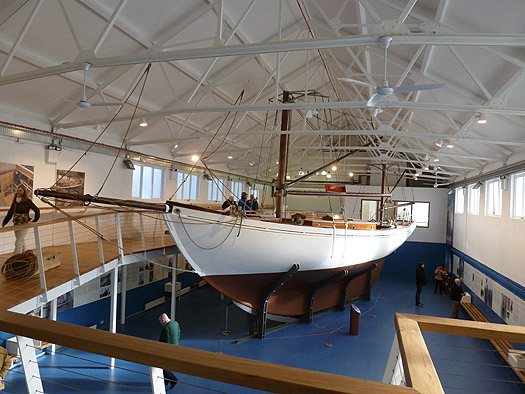
The conserved Asgard on display in the museum at Collins Barracks. The exhibition provides a valuable insight into the cruising yachts of her era, and the human story of those involved in a complex historical episode. Photo: W M Nixon
A True Story That Actually Happened
#sywoc – When something seems just too good to be true, it usually is. But just now and again, though only very occasionally, it is good and it is true.
On Wednesday evening, followers of the Irish team in the Student Yachting Worlds at La Rochelle in France were in a state of wonderment and hope. Could it really be that, after 13 races and a "Stewards' Enquiry", UCD were actually leading overall by all of 12 points?
And after all the disappointments at the final hurdle in so many international sailing events this year, could it possibly be the case that with just two more races to sail, admittedly in a decidedly hot fleet, could it be that Cathal Leigh-Doyle and Aidan McLaverty and their crew of ten could hang onto their lead right through to the prize-giving today – after all, it only needed them to be just one tiny little point clear?
In such a situation, first thing is a look at the weather prospects. Mostly the breezes in the region were fresh west to southwest, but the forecast charts showed a bullet of stronger wind barreling its way up the Bay of Biscay, right on line for La Rochelle through Thursday and yesterday.
Initially it didn't look too rough, but then we got to thinking that they'd go out to race in tough conditions, and UCD might get dismasted. That's the way you get to think after a season of disappointments like 2012. But the ill wind blew Ireland good. It arrived as a gale, and further racing was eventually cancelled. We were home and dry.
It had been an excellent series already, and the Irish team had excelled both inshore and offshore. For part of this week, they were racing in the knowledge that points gained in the second race had been lost through an alleged start line infringement. But eventually an official analysis of video evidence showed Ireland to be all clear, and with the points reinstated they moved into this massive overall lead.
"Massive overall lead", however, has been the bugbear of Irish international sailing this year. Get one early in any major series, and the opposition will naturally gang up on you. But thanks to the weather, this time they didn't have the opportunity, and in truth it's difficult to see what they could have done anyway, short of outright sabotage.
Our team were Cathal Leigh-Doyle, Aidan McLaverty, Barry McCartin, Ben Fusco, Simon Doran, Theo Murphy, David Fitzgerald, Ellen Cahill, Isabella Morehead and Alyson Rumball. They come from every corner of Ireland, they represent virtually all the main sailing centres and many smaller ones throughout the country, and they've all done us proud.
Amidst this deserved euphoria, there's no better time to put the record straight on Ireland's scorecard in student world championships, about which we've all been a bit confused, not least this column.
The Student Yachting World Cup is now top of the bill, but although it was founded back in 1979, another competition in France tried to claim its crown. That was the Course de L'Europe at Le Lavandou in the south of France, which had a greater emphasis on offshore racing. In 1988, Trinity College Dublin took part representing Ireland, and they placed third overall out of twenty national teams, an impressive fleet which the current competition has not recently matched. The Irish team nearly a quarter of a century ago was Gary MacCarthy, Paddy Oliver, Sean Hooper, Sarah Webb, Helen Cole, Jamie McWilliam and Roger Morris, with Glen Reid as manager.
Fast forward eighteen years, and in 2006 Trinity are again Irish champions, and this time they're racing in the Student Yachting World, staged as usual at Hallowe'en, and on that occasion at Lorient. They won. By 2008, Irish university interest in the SYWoC is growing every year, and taking part in it is regarded as the peak of our inter-collegiate sailing. That year, Cork Institute of Technology with Nicholas O'Leary as skipper are Irish champions, and they go on to win the SYWoC at La Trinite, giving it an even higher level of national interest back home.
The story since 2008 is part of Irish sailing lore, and UCD's very thorough and successful campaign towards this year's victory is eloquent testimony to the remarkably high level of university sailing in Ireland. This is good news morning.
WILL YOUR BOTTOM LOOK BRIGHT ENOUGH IN THIS?
One of the interesting points to emerge from this week's report into the capsize of Rambler 100 in last year's Fastnet, and the subsequent successful rescue of her large crew, is the suggestion that boats which are liable to invert might usefully have their bottoms coated with high visibility paint.
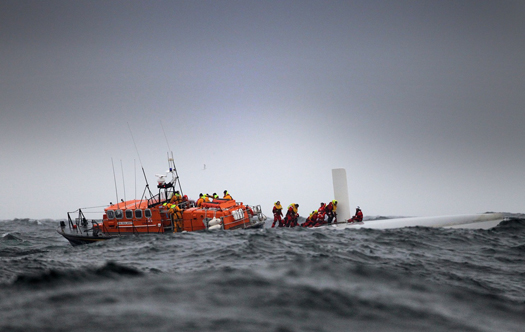
Rambler 100s upside down hull was hard to spot. Photo: Team Phaedo
For all her great size, the capsized Rambler was remarkably difficult to spot on that grey evening, as her upturned white hull was easily mistaken for a breaking wave.
It sounds like a neat idea, but some agreed definition of boat that is likely to capsize would be a necessary starting point. After all, having a dayglo orange bottom will amount to a statement that your boat is pushing the envelope of lightness and exceptional ballast leverage to the absolute limit, upon which all old salts will say that it's damned unseamanlike, and shouldn't be permitted out of the harbour in the first place.
Then too, which particular shade of dayglo would sir or madam prefer? While extremely useful and indisputably life-saving, when considered purely as colours they're all horrible - in fact, the more horrible, the more effective they become.
Time was when all sorts of notions attached to the different colours of anti-fouling bottom paint, and as most of them change in shade as the season progresses, all sorts of debates are possible on which is the more effective, and at what time in the year.
In the old days, the feeling was that only red anti-fouling was effective – it was something to do with the lethal chemicals which could be successfully incorporated in red. Black was also supposed to be okay, but not blue, and – surprisingly – not brown, despite its relative closeness to clean copper. But of course green like weathered copper was and is much approved – it's what I use myself, but it has to be admitted that's mainly because I simply like the look of it.
One colour which used to be regarded as wellnigh impossible was white, which made it a challenge for amateur chemists. Back in the day when boats were still kept in Ballyholme Bay, I can remember as a kid that the annual launch of the little keelboats of the Bay Class used to see the slipway area kept clear for one boat which would arrive without the anti-fouling already applied. She would be set up ready for launching at the top of the slip, and then the owner would arrive at high speed on his bike, with the carrier loaded with cans of white anti-fouling to his own recipe which he'd been mixing at home in the kitchen, This anti-fouling would be applied in jig time, and the boat then was hurled down the slip into the water, as the magic brew was supposed to lose its potency in fresh air even more quickly than standard anti-foulings.
It looked very smart - white topsides, red boot-top, and white bottom – but the boring boats with the red anti-fouling were always winning by mid-season. But then, in those days antibiotics weren't part of everyday life. Today you'd be regarded as anti-social and an ecological hooligan if you put veterinary anti-biotics into your anti-fouling, but it works.
And I'm told essence of horseradish works quite well too. But this seems to be taking us away from the subject of the colour of boats' bottoms for safety purposes. So maybe we should be talking with our neighbourhood whales. Seafaring lore would have it that whales tend to attack boats with white or red bottoms, but will leave blue, black or green alone. So what are whales likely to make of the heroically revolting dayglo lime, let alone the standard dayglo orange?
Old Hopes on Young Shoulders
#sywoc – An all-Ireland squad represents us in the Student Yachting Worlds getting under way in La Rochelle in France with the practice race today, the team drawn from Sligo, Mayo, Belfast, Wicklow, Dublin, Cork and Antrim.
At the end of an international season which has seen some of our best-known sailing stars hit the heights only to miss the podium at the very end, the amount of hope which is being invested by the Irish sailing community in the national college team is unreal. But that's the way it is at this level of sailing, and in their season-long buildup to the big event in the Bay of Biscay, the team of ten have been getting every sort of encouragement, advice, training and assessment from the best sources available.
The French started this series back in 1979, and it has been gradually growing in stature ever since. It's their baby, so it's their own affair if they persist in calling it a "yachting" event. But everywhere else has long since thought of our sport as sailing, so it's pure Gallic pig-headedness to persist with the clunky yachting tag, particularly for a series which highlights the sailing stars of the future.
The teams are provided by the winners of each country's national intrcollegiate championship, and way back in 1988 Trinity, after winning the Irish title, went on to become the first Irish world champions. This year, UCD did the business on the home front back in March by winning the Irish title in Dun Laoghaire, breaking a long and successful stranglehold by CIT.
The Cork sailors had a great run of it in the Worlds, with second in 2007, first in 2009 when Nin O'Leary was skipper, fourth in 2009, and a remarkable third in 2011 with George Kenefick the skipper –it was remarkable as the draw had given CIT one of three boats that were definitely not up to standard.
UCD are captained by Cathal Leigh-Doyle from Ballincar in Sligo, while the crew skipper is Aidan McLaverty. Others in the lineup are Barry McCartin (tactician), Ben Fusco, Simon Doran, Theo Murphy, David Fitzgerald, Ellen Cahill, Isabella Morehead and Alyson Rumball.
In addition to supervised workouts in UCD's performance gym, they've been intensively training afloat under the watchful eye of Nin O'Leary, John Downey, Marty O'Leary and Maurice "Prof" O'Connell. And Olympic helm Annalise Murphy, who was contemporary at UCD with many of the crew in First Year, but took time out for her sailing challenge, has been getting together with them in support.
Racing is from tomorrow through November 3rd. It's a fleet event with 14 national teams including the US, Canada and Australia, with France's Euromed team the defenders. The programme includes inshore, offshore and coastal races, and early indications are of lightish north to northeast breezes in the racing area. But a lot can happen weatherwise in the last week of October, and we can be sure many Irish sailing fans will be closely watching meteorological movements off La Rochelle for the next seven days.
GILDED YOUTHS BECOME GOLDEN OLDIES
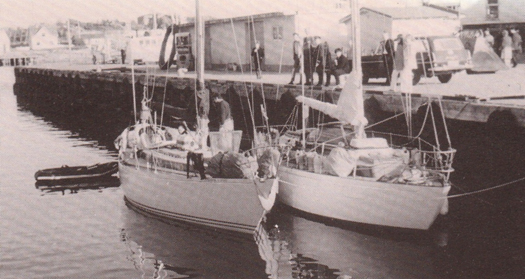
The Dun Laoghaire boats Clarion and Felise in Svolvaer in northern Norway in 1970, crewed almost exclusively by young sailors recruited through the university sailing clubs in Dublin
Encouraging the university sailing scene is a demanding business, as the turnover in talent is so rapid. The notion of the desirability or otherwise of three years degree courses is sensibly being challenged by the Slow Learning Movement. This informal international grouping hastens to tell us it's not about slow learners as popularly perceived, but is about tailoring and shaping courses and the time allotted to suit individual needs.
It's a decidedly luxurious ambition for sure, and hardly a runner in a time of economic recession, even if a popular way of passing the time before the financial wheels begin to turn again is to find some college offering post-grad courses with student support grants.
Nevertheless, even with four year courses, plus the addition of post-grad input, no sooner does a college sailing club begin to get a winning squad together than they've either graduated or been sent down. Sometimes a winning team finds itself so seriously and suddenly de-populated that truly creative solutions have to be found to define just who is or is not a student, and at what college.
It's only a matter of time before they offer degree courses in dealing with the challenge of keeping college teams up to strength and together. American universities are way ahead of the curve with their sports scholarships and many other sorts of imaginative funding. But it's not generally realized that, back in the day, Dun Laoghaire was a world leader in encouraging university sailing.
This happy state of affairs developed as the Irish Dinghy Racing Association grew in strength in the late 1940s and through the 1950s. The Firefly class was at the core of dinghy sailing in Dublin Bay, and the three waterfront clubs were in a dynamic interaction with UCD, TCD and RCSI.
For those of us from universities less favourably set up in their sailing, it was a real revelation to come to Dun Laoghaire and find UCD well placed with the National YC, Trinity in comfort at the Royal St George, and College of Surgeons in situ at the Royal Irish.
The system worked very well. All the Dublin-based university sailing teams were in the front rank of top level competition with British colleges, the only international competition available in those days. And student life being more leisurely in those days, the undergraduates added significantly to numbers competing at summer events like Dinghy Week.
The arrangement was of course a matter of enlightened self-interest by the powers that be, as it introduced each waterfront club's senior sailing members to young and energetic potential crewmen and crewwomen. There's many a golden oldie offshore racing or cruising skipper about Dublin Bay these days who got his or her first taste of big boat sailing thanks to the introductory services indirectly provided though having university sailing clubs using the big clubs' premises.
The system reached a high point in 1970 when two Irish cruising boats met up in Svolvaer in the Lofoten Islands off the far north of Norway. The locals were very impressed – they said it was the first time two sailing craft had been together in the harbour in fifty years, for this was long before the Arctic's current popularity as a cruising destination.
One of the boats was the 13-ton sloop Felise, owned by Ninian Falkiner, Commodore of the Royal Irish. The other was the 43ft Clarion of Wight, owned by Rory O'Hanlon, Commodore of the Royal St George. And in both cases, their crews were made up almost entireely of young sailor recruited through the university sailing clubs.
BIRDS ON BOARD
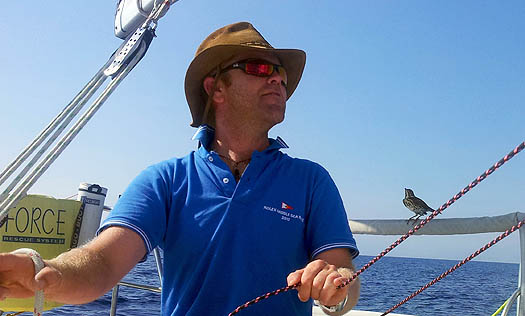
Barry Hurley en route to winning the double handed class of the Middle Sea Race this week
By the time this is on the screen, we'll know how Barry Hurley and Andrew Boyle finished in the two-handed division in the Middle Sea Race. (It's a win! - Ed) But meanwhile everyone visiting the Afloat.ie website recently has been enchanted by the photo of Barry sailing along in the race, and getting every encouragement from a visiting sparrow beside him, perched on the guard rail.
Of course it's not natural, it's not what sparrows would like to be doing, but inevitably we empathise with the little thing, and wonder what's going on in that particular bird brain. Inevitably, the assumption is that it will end unhappily - the bird must have been exhausted to take up such an unlikely perch in the first place. But such stories can sometimes have a happy ending.
Many years ago we were returning from the Isles of Scilly towards the Tuskar after an early-season cruise to Northwest Spain. It was mid-June, so migratory birds were still heading northwards, but even so it was a matter of wonder as we sailed along that a swallow found its way through the companionway and into the saloon.
My shipmate Davy McBride is one of those people with an easy affinity with wildlife, and instinctively he held up his arm and the swallow settled on it, very much at ease. The little bird eventually found a temporary nest under the sprayhood beside the warmth coming through the companionway.
We made our landfall on track, but were quite close to the Wexford coast before that evocative aroma of the land came out to us – as they say in Irish Lights when they have favourable conditions for working at buoys and other navigational aids, "the wind was off the grass".
Our little passenger, who had taken some drinking water, bestirred himself, fluffed out his feathers, and then took off with a cheerful chirrup. He didn't fly immediately to the nearby land, but did a couple of circuits of the boat before taking his departure towards Wexford. We remember that so clearly, years after supposedly more important details of the cruise to Galicia have long since faded away.
Monster Wave Hits Cork But Local Heroes Rise Above it
#corkharbour – Back in 1992, we were sailing a true cruiser-racer which was moderately competitive despite going off for a proper cruise or two each year. In that year we did Cork Week and lived aboard the boat in true cruiser-racer fashion – in fact, the security man checking my pass at the end of the week said it showed I'd never gone to the landward side of the Royal Cork compound throughout the regatta, which on reflection I had to say was indeed true.
Anyway, on that last day before I finally ventured into nearby County Cork, we had a breezy race with lots of wind between south and southwest, and as the ebb was running hard I can remember taking it easy going out to the start, because for once we had time in hand and the space to avoid the tide rip which develops in those conditions off Roche's Point.
We were trundling along, and suddenly Ted Crosbie's boat (it would have been one of his earlier excursions into the X Boats) came rocketing past heading seaward at full speed carrying all sail. His start was earlier than ours, and he was late. It may be that he wanted to teach whoever had kept him late a fierce message, or maybe he did it for the hell of it, but he just went straight through the breakers at full chat (despite his affable appearance, Ted is one tough cookie) and came out the other side still going strong, and with us marvelling that his boat was still in one piece, and joking about the citizens of Cork having such an excellent boat test tank right on their doorstep.
Mock not, lest your predictions come true. Since 2006, Frank Kowalski and his team at Safehaven Marine in Cobh have been putting their Pilot and Search & Rescue boats through the demanding test bed off Roche's Point, and the success of the company is testament to the thorough nature of the conditions experienced when there's an onshore gale and the ebb is running strong.
It all started with a boat for Cork Harbour, though I should imagine the Cork Harbour authorities have mixed feelings about the way the entrance to their "safest harbour in the world" is now being used to publicise the marque. But fair play to the men of Cork, they backed a winner, and these days the Safehaven boats are sold to harbour authorities and other maritime bodies all over the world, with the company employing 25 highly skilled staff between their factories on Little Island in Cork Harbour, and in Youghal.
It's very much a team effort, and usually when they want to take a boat out to test, other boats may go along to observe and photograph. But if things are just too much, or the factories are extra busy, all they need is one guy with a camera down on Roche's Point.
This recent sequence was taken from another boat, and it shows former naval diver Ciaran Monks putting the newest in the sequence of pilot and rescue vessels through her paces. For once, the word awesome can be allowed. No other word will do. Frank Kowalski and his team are an inspiration to us all.







































































